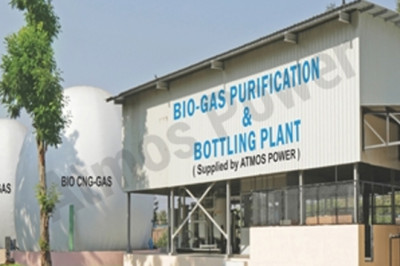views
Steel beams are essential components in the construction industry, providing structural support and stability to various building projects. Their versatility, strength, and durability make them indispensable in a wide range of applications, from residential and commercial buildings to bridges and infrastructure projects. In this comprehensive article, we will delve into the different types of steel beams, their applications, the manufacturing process, and factors to consider in the selection. Besides, we will also discuss its advancements in technology, environmental impact, and future trends.
Types of steel beams
- I-beams:
Also known as universal beams, are characterised by their distinctive "I" shape. These beams have flanges on either side of a central web, offering high strength and load-bearing capacity. They are commonly used in construction projects that require long spans and robust support, such as high-rise buildings, bridges, and industrial structures.
- H-beams:
H-beams, also called wide flange beams, have a shape resembling the letter "H." They feature wider flanges and a thicker web compared to I-beams, providing greater structural stability. H-beams are frequently used in residential and commercial construction, as well as in bridge construction and infrastructure projects.
- T-beams:
Also referred to as tee beams and have a T-shaped cross-section. These beams are commonly used in reinforced concrete construction, where the flange of the T-beam acts as a reinforcement for the concrete slab. T-beams are widely employed in floor and roof construction, offering strength and flexibility.
- Other types of steel beams:
Apart from the three main types mentioned above, there are various specialised steel beams used in specific applications. Box beams, for instance, consist of hollow rectangular or square sections and are often employed in architectural and aesthetic designs. Composite beams combine steel with other materials, such as concrete or timber, to optimise structural performance.
Applications of steel beams
Steel beams find extensive applications in the construction industry, catering to diverse structural requirements. Here are some notable applications:
- Residential construction:
They are commonly used in residential construction to support load-bearing walls, create open floor plans, and provide stability to multi-story buildings. They facilitate the construction of large, open spaces, allowing for flexible interior designs and reducing the need for interior columns.
- Commercial and industrial construction:
They play a vital role in the construction of commercial and industrial buildings, such as warehouses, factories, and shopping centers. They provide the necessary structural support to accommodate heavy equipment, machinery, and storage systems, while also offering the flexibility to adapt spaces to changing needs.
- Bridges and infrastructure projects:
They are extensively utilised in bridge construction due to their high strength-to-weight ratio and ability to withstand heavy loads. They are employed in the construction of bridge decks, girders, and supports, ensuring the durability and stability of these vital transportation structures. Steel beams also find applications in other infrastructure projects like railway stations and airports.
- Specialised applications:
They are employed in various specialised sectors, including shipbuilding, offshore platforms, and aerospace. In shipbuilding, steel beams provide structural integrity and stability to vessels, while in offshore platforms, they support the weight and dynamic forces of drilling rigs. In the aerospace industry, steel beams are utilised in the construction of hangars, maintenance facilities, and support structures.
Manufacturing process of steel beams
The manufacturing process of steel beams involves several stages, ensuring the production of high-quality and reliable structural components. Here is an overview of the process:
- Raw materials and selection:
The production of steel beams starts with the selection of appropriate raw materials, usually in the form of steel billets or blooms. These raw materials undergo stringent quality control measures to ensure they meet the required specifications for strength and composition.
- Steelmaking and refining process:
The raw materials are melted in a furnace, typically an electric arc furnace, where they are heated to high temperatures. This process removes impurities and allows for precise control of the steel's composition. The molten steel is then refined further to achieve the desired chemical properties.
- Casting and rolling process:
Once the steel has been refined, it is cast into billets or blooms, which are then reheated and passed through rolling mills. The rolling process shapes the steel into the desired beam profiles, such as I-beams, H-beams, or T-beams. Multiple passes through the rolling mills help achieve the required dimensions and uniformity.
- Heat treatment and shaping:
Depending on the desired properties, the steel beams may undergo heat treatment processes such as quenching and tempering, which enhance their strength and toughness. Shaping processes, such as cutting, drilling, and punching, is carried out to create the necessary holes, notches, or connections as per the project requirements.
- Quality control and inspection:
Throughout the manufacturing process, rigorous quality control measures are implemented to ensure the beams meet the specified standards. Non-destructive testing methods, such as ultrasonic testing and magnetic particle inspection, are utilised to detect any surface or internal defects that may affect the structural integrity of the beams.
Factors to consider in steel beam selection
When selecting steel beams for a construction project, several factors should be taken into account:
- Load-bearing capacity:
The beams must be capable of supporting the anticipated loads and forces exerted on the structure. Structural engineers calculate the required load-bearing capacity based on factors like building design, occupancy, and environmental conditions.
- Span and deflection requirements:
The span of the beams, or the distance between supports, influences their size and design. Additionally, deflection requirements determine the allowable amount of beam bending under load, ensuring the structural integrity and aesthetics of the building.
- Cost and availability:
Cost considerations, including material and fabrication costs, play a crucial role in beam selection. The availability of specific beam types and sizes should also be assessed to ensure timely procurement.
- Corrosion resistance:
In corrosive environments or areas prone to moisture, such as coastal regions, beams with adequate corrosion protection should be chosen. This ensures long-term durability and minimises maintenance requirements.
- Aesthetic considerations:
In architectural designs, the visual appearance of the beams may be a crucial factor. Architectural steel beams can be customised to meet specific aesthetic requirements, adding a unique touch to the building's design.
Advancements and innovations in steel beam technology
The field of steel beam technology has witnessed several advancements and innovations in recent years. Some notable developments include:
- High-strength steel and advanced alloys:
The development of high-strength steel and advanced alloy materials has significantly enhanced the strength-to-weight ratio of steel beams. These materials allow for the design of lighter and more efficient structures without compromising on structural integrity.
- Prefabrication and modular construction techniques:
They have gained popularity in recent years. Steel beams can be manufactured off-site and delivered as pre-assembled components, reducing construction time and improving overall project efficiency.
- Computational modelling and optimisation:
These include as finite element analysis and parametric design, enable engineers to simulate and optimise the performance of steel beams. These tools aid in improving beam designs, optimising material usage, and reducing costs.
Environmental impact of steel beams
The production and use of steel beams have environmental implications that should be considered. Some key aspects include:
- Energy consumption and carbon emissions during production:
The manufacturing process of steel beams consumes significant amounts of energy and releases carbon emissions, contributing to greenhouse gas emissions. Efforts are being made to reduce energy consumption and transition to cleaner production methods.
- Recycling and sustainability initiatives:
They are highly recyclable, and the recycling rates for steel are relatively high. Recycling steel beams helps conserve natural resources, reduce energy consumption, and minimise waste.
- Life cycle assessment and eco-friendly alternatives:
Life cycle assessments can evaluate the overall environmental impact of steel beams, considering factors such as extraction, production, transportation, use, and disposal. Additionally, research and development efforts are focused on exploring eco-friendly alternatives, such as sustainable materials or innovative construction techniques, to reduce the environmental footprint of steel beams.
Disclaimer: The authors, editors, and publishers of this article do not accept any responsibility or liability for any errors, omissions, inaccuracies, or outdated information contained herein, or for any actions taken based on the content of this article. Readers are solely responsible for their own decisions and actions.











